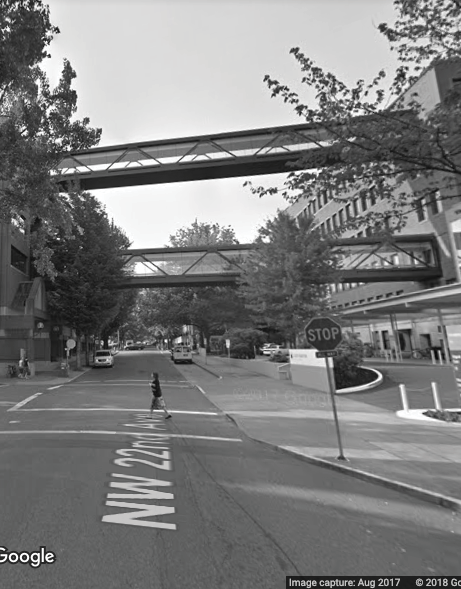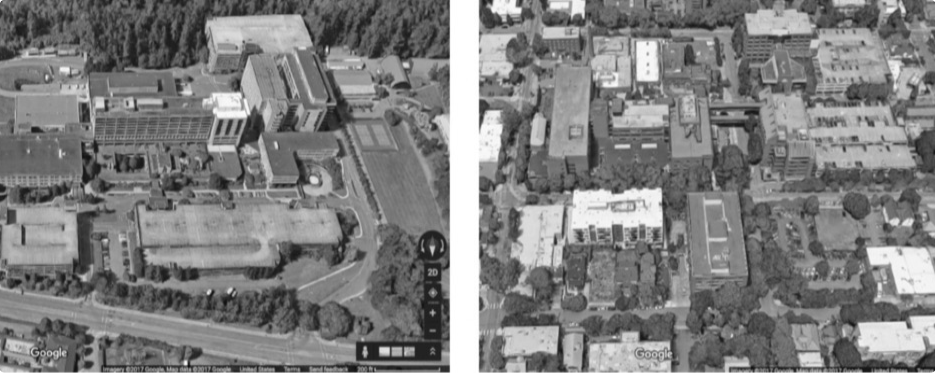…Also at the edge of a Pedestrian Sanctuary and within the 400M Through Street Network there is a need to accommodate medical facilities, following the principles of Biophilic Urbanism.

__Problem-statement: Hospitals have advanced requirements for germ isolation and patient protection; yet their patients also have a basic need to stay connected to their neighborhood environments.__
Discussion: In the past, it was assumed that the best way to maintain sterile conditions and patient comfort was to isolate hospitals in remote campus locations. This practice has caused excessive driving for patients and staff, and contributed to the fragmentation of urban areas.
However, a hospital facility need not be confined to a single massive building. Many hospitals successfully use a cluster of several buildings, inter-connected with subterranean spaces as well as overhead bridges. Sensitive areas can be located in the subterranean levels, such as surgery and nuclear medicine facilities.

Two hospitals in Portland, Oregon — one a disconnected supercampus that requires driving for almost all visits, and the other, integrated into the walkable neighborhood fabric.
In this way, the hospital complex can integrate with the surrounding walkable street network, providing a vital connection for patients to the life of the neighborhood.
In addition, there is a growing recognition of a connection between healing environments and the desire for close exposure to nature, or so-called “biophilia”. This recognition is now driving the “greening” of hospitals, as they move away from an isolated industrial factory typology, and toward a model that embraces the neighborhood and its human and natural life.1,2
__Therefore: Build hospitals as integrated facilities within their neighborhoods. If necessary, use bridges, tunnels and subterranean levels to connect different buildings and functions as needed across the walkable street fabric.__

Create a Walkable Streetscape around the hospital, with a mix of other uses including clinics, offices, commercial spaces and residences…
notes
¹ A major movement in so-called “biophilic” hospital design was begun in part by a famous paper by Roger Ulrich (1984), “View through a window may influence recovery”. Science, 224(4647), 224-225. (Available on the Web at https://is.muni.cz/el/1423/jaro2014/HEN597/um/47510652/Ulrich_1984.pdf.) Since then, the field has developed significantly. However, biophilic hospital design requires more than just siting a building in a remote leafy locale. As Yannick Joye noted, the buildings and the surrounding urban environment also need to reflect biophilic principles. See Joye, Y. (2007). Architectural lessons from environmental psychology: The case of biophilic architecture. Review of General Psychology, 11(4), 305- 328.
² Another important dimension of hospital design, especially acute in the developing world, is the provision of essential standards of water, sanitation, hygiene, and health care waste management and cleaning (known by the acronym WASH). These must be provided by the infrastructure supplying the hospital, as an integral part of the hospital planning, and the urban planning around it. But as this Global Baseline Report from the World Health Organization and UNICEF makes clear, too many places do not have adequate standards. And it is an urgent priority now to provide them. See https://washdata.org/sites/default/files/documents/reports/2019-04/JMP-2019-wash-in-hcf.pdf
See more Special Use Patterns